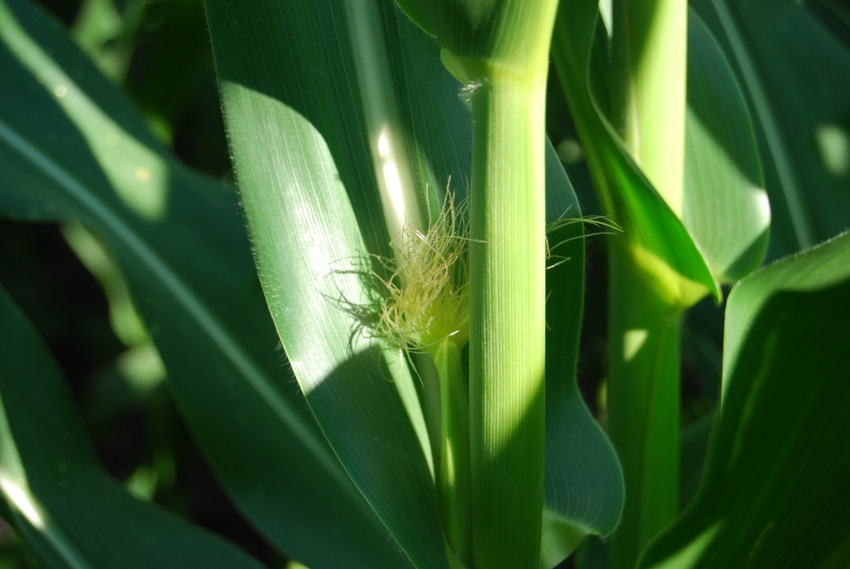
While other areas of Iowa caught some rain last week, southeast Iowa had to settle for a few sprinkles. Many areas there remain dry. Southeast Iowa’s topsoil moisture levels fell for the sixth consecutive week, with 82% of the region rated “short to very short” on topsoil moisture, according to the weekly USDA Crop Progress survey of conditions for the week ending July 2.
“The corn and soybean crops down here are still looking pretty good, for as dry as it is,” says Kurt Hora, Iowa Corn Growers Association president, who farms in Washington County. “Hopefully, we’ll catch some rain before the heat moves in and pollination begins.” ICGA sponsors the Iowa Corn 300 Indy car race, an annual ethanol promotion at Iowa Speedway at Newton. This year it’s July 9. “This is the 11th year for the race, and I think 9 or 10 of those years it’s rained the day of the race,” says Hora. “So I’m forecasting rain for July 9, the day of the Iowa Corn 300.”
Crops across state need rain
“Despite the periodic storms last week, crops across much of the state could use a good rain. This is especially true in southeast Iowa,” notes Iowa Agriculture Secretary Bill Northey. “Even with the dry condition, Iowa’s crops are making good progress, and 78% of the state’s corn and 72% of the soybeans are rated good or excellent.”
The complete weekly crop and weather report is available on the Iowa Department of Agriculture and Land Stewardship website at IowaAgriculture.gov or on USDA’s site at nass.usda.gov/ia. The report summary follows here.
Scattered tornadoes, hail and rainstorms
Iowa experienced scattered tornadoes, hail and isolated rainstorms, but reporters expressed need for more rain across much of the state during the week ending July 2, according to USDA’s National Ag Statistics Service. Statewide there were 4.6 days suitable for fieldwork. Activities for the week included herbicide application, cultivating and haying.
Topsoil moisture levels rated 6% very short, 21% short, 68% adequate and 5% surplus. Southeast Iowa’s topsoil moisture levels fell for the sixth consecutive week, with 82% now rated short to very short. Most of southeast Iowa was categorized as abnormally dry by the U.S. Drought Monitor, released June 27. Subsoil moisture levels rated 4% very short, 15% short, 77% adequate and 4% surplus.
Iowa corn rated 78% good-to-excellent
The survey shows 78% of the state’s corn crop is rated in good-to-excellent condition. Soybean emergence is nearly complete. Soybean blooming reached 12% complete, three days behind last year and two days behind average. Soybean condition rated 72% good-to-excellent. Oats headed reached 94% for the week, one day ahead of the five-year average. Oats coloring reached 27%, five days behind last year and three days behind average. Oat condition rated 74% good-to-excellent.
The second cutting of alfalfa hay reached 27% complete, five days behind last year and two days behind average. Hay condition rated 78% good-to-excellent. Pasture condition continues to decline with 63% good-to-excellent. Livestock were generally reported to be in good condition due to favorable temperatures, while farmers in a few areas may need to start supplementing feed for cattle in pastures.
Weather summary for Iowa
The past reporting week began June 26 with unseasonably cool weather prevailing through the next day, June 27, notes Harry Hillaker, state climatologist with IDALS. Daytime highs were mostly in the 70s, with nighttime lows in the 40s and 50s during that first one-half of the week. Grinnell and Battle Creek reported the week’s lowest temperatures with 40-degree readings on the morning of June 27. Light rain was scattered across the southwest half of Iowa the night of June 25 into June 26, while June 27 was dry. Very warm and humid weather made a brief return on June 28, with Sioux City and Little Sioux reaching 90 degrees.
Rain fell statewide on June 28 with greatest amounts concentrated in the northeast and southwest corners of the state. Slightly cooler-than-normal weather prevailed for the remainder of the week. Thunderstorms brought rain to most of the northwest one-half to two-thirds of Iowa on June 29. There were a few isolated showers over the northwest one-half of the state on June 30. July 1 was dry, while there were a few isolated showers over the southwest one-third on July 2 in the morning.
Week averages 6 degrees below normal
Statewide average temperature for the week was 6 degrees below normal. Weekly rain totals varied from only 0.09 inch near New London in far southeast Iowa to 4.70 inches at Fort Atkinson in Winneshiek County. The statewide average rainfall was 1.22 inches, or slightly more than the weekly normal of 1.13 inches. Rain totals were well below normal over much of the southern two-thirds of Iowa for the week with some areas seeing much less than usual rain over the past five to six weeks.
Meanwhile severe weather was reported from 19 counties on June 28 and 20 counties on June 29. Large hail was reported over portions of Woodbury, Page and Dallas counties, while numerous tornadoes touched down in southwest, south-central and east-central Iowa with these midweek storms.
About the Author(s)
You May Also Like




